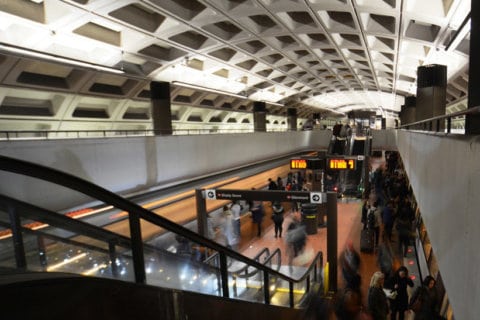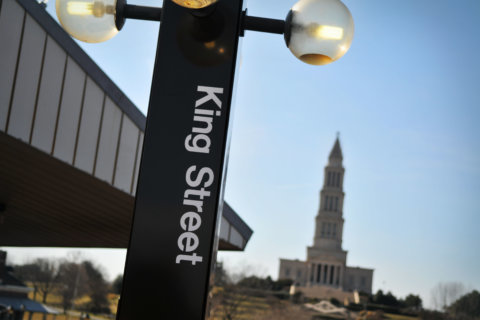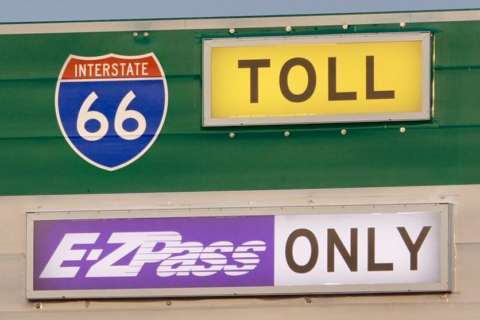Metro’s push for more ad revenue to address continued budget challenges could lead to ads tracking riders throughout the system.
Instructions to companies interested in taking over Metro’s advertising sales describe a major push toward more digital advertising screens that come with sensors to detect Wi-Fi, Bluetooth or other signals.
Those signs could be used on the advertising side to make more money by individually targeting sales and promotions and — on Metro’s operations — side to determine how riders move through the system.
“WMATA has already begun to develop a network of digital display units and seeks to expand that network through digital place-based and location-based devices and programs,” the Metro contracting document explained.
“In addition to digital, WMATA looks to beacon and other technologies that would not only engage riders but would also provide the Authority with valuable data that could increase the productivity of its services.”
The practice mirrors that of many retail stores that have similar technology in place now, where the store or advertiser can ping a phone that is in the store or passing by.
Metro is specifically looking for “anonymized data regarding passengers, interaction/viewing of devices (age range, gender, attitude), and any other data that can assist in ad sales and/or passenger communications.”
Metro would own all of the data collected from the screens and related systems.
“Respondents should propose opportunities to monetize the data collected from the devices, technologies and programs developed under the contract resulting from this Request for Proposal with WMATA sharing in revenues from that monetization at the same rates established for the advertising devices, technologies and programs,” Metro wrote.
In addition to the advertising contract, Metro is also pursuing the installation of Bluetooth sensors or similar technology at all station entrances and along key bus lines. The primary purpose of that project is to support an app that would provide audio information to blind, low-vision or other riders on how to find their bus stop, transfer or train from their current location.
The app is also expected to provide information on when the next bus will arrive, and could possibly alert the bus driver to the fact that a person with a disability is near the stop.
Metro hopes this would reduce the number of people taking more costly paratransit trips.
The app could launch on a limited basis by the end of this year using the seven Metrorail stations that already have Bluetooth beacons at their entrances.
It would roll out to all other stations and certain other parts of the transit system, including 2,200 bus stops, by sometime in 2021. Priority bus routes for the project include X2, 70, 80, B2, 79, 90, 54 and 92.
Digital screen expansion
Since Metro first installed permanent digital advertising screens in 2016, the proportion of revenue from those screens has skyrocketed.
In the budget year that ended June 30, Metro advertisers were billed $42 million, about $7 million more than the previous year. That included $9.5 million in digital sales, nearly double the previous year.
Traditional static ads in the rail system brought in $19.6 million, while static bus ads brought in $12.7 million.
After the share taken by the current sales contractor, Metro got $28.5 million, up from $23.8 million the year before. The transit agency hopes to get at least 70% of revenue under the new contract.
Metro added 68 new 65-inch LCD screens this summer at stations closed during the Blue and Yellow Line shutdown that ends Monday. Metro pays the digital sign power costs.
In a response to potential bidders on the new advertising contract, Metro said it is “unknown” how long the screens installed over the past few years will last.
Still, Metro plans to add at least 1,500 more digital screens across the system over the next five years. Some of the screens that provide additional rider information would include a speaker to read out text, tactile keypads or Braille to provide the same information to riders who cannot see the screens clearly.
At least 25% of the time or space on the screens will continue to be reserved for Metro messages.
The contractor would have to alert Metro to any data breach or hacking, and must follow cybersecurity standards.
Even the workers installing the signs would be tracked, since Metro is requiring them to tap in and out of stations with a SmarTrip card, paying for their time there.
Construction of the new screens is not supposed to disrupt rail service.
Naming rights still on the table
Metro is reserving the right to sell naming rights to stations, lines or the whole system separately from this advertising contract, although there are no current plans to do that.
Any vending machines, ATMs or staffed stands, such as newsstands, that could be approved in or around stations would also be separate.
The advertising deal does include the opportunity to sell ads in the right circumstances not just in Metro stations, trains and buses, but also at and outside other Metro facilities.
Examples include maintenance facilities, rail yards, bus garages, office buildings and police facilities.
Metro is also looking for better ways to sell advertising and special event designs on SmarTrip cards.
Metro is only willing to sell ads on the outside of 40 rail cars at a time, though.
All ads would still have to follow Metro’s advertising guidelines, which have withstood numerous legal challenges since their 2015 approval.
Bids on the advertising contract were originally due Friday, but the deadline has been extended into next month.
PRTC OmniRide and VRE are also expected to be covered under the contract through a regional procurement agreement.
Metro hopes to award the contract in late November, but it would start next year.







